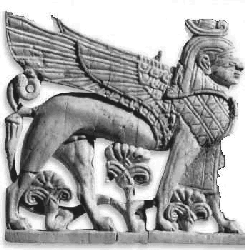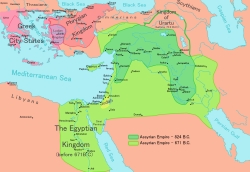NōꞋakh 1st Eve (Mo•tzâ•eiꞋ Shab•âtꞋ Beginning Week)
(Continuation of Pâ•râsh•atꞋ bᵊ-Reish•itꞋ)

Gan EiꞋdën Lost
 |
| Kᵊruv: Assyria BCE 9th-8th century, Ivory |
Because •dâmꞋ and Khaw•âhꞋ disobeyed His mi•tzᵊwâhꞋ, ä' Ël•oh•imꞋ removed •dâmꞋ and Khaw•âhꞋ out of Gan EiꞋdën in nearby kᵊruv•imꞋ, which had spinning blades glinting in the sun.
 |
The location of Gan EiꞋdën hasn't been found, perhaps destroyed by an earthquake and tectonic shift that changed the courses of the rivers that had irrigated Gan EiꞋdën, submerging Gan EiꞋdën beneath the Persian Gulf – perhaps inspiring the ancient story of Atlantis.

Optional parental preparation:
- It's essential that your child realize that these are real places. This is essential to the authenticity of historical characters and events, distinguishing these from fairy tales. Review so you can find and show them if needed, where, on a globe, the following are located: you, the Persian Gulf, where an ancient land bridge was, separating the Persian Gulf from the Arabian Sea, at the Strait of Hormuz, the Tigris and Euphrates rivers and Mesopotamia (lit. meaning "between the rivers"). Review which countries these are today (Iraq, Iran, Syria, Turkey)
- Be prepared to explain how tectonic movement causes earthquakes.
- Use a fan and flashlight to demonstrate how a spinning blade glints light
Questions you might anticipate that your child might raise and be prepared to discuss:
- Where was Gan EiꞋdën?
- Where are the Tigris and Euphrates rivers? (And where is Iraq?)
- What is a kᵊruvꞋ (pl. kᵊruv•imꞋ)?
- What is a mi•tzᵊwâhꞋ (pl. mi•tzᵊw•otꞋ)?
Google+ registered author & publisher

